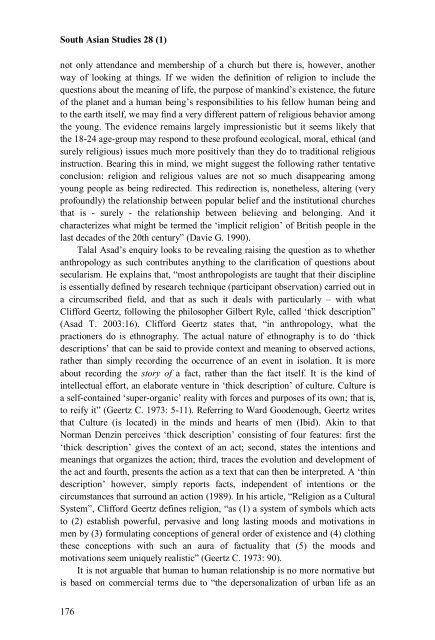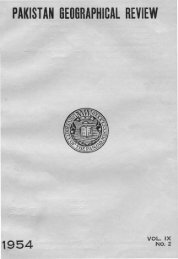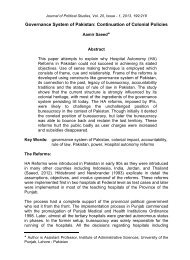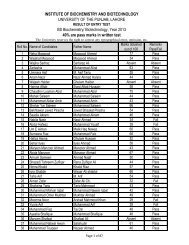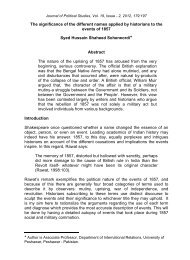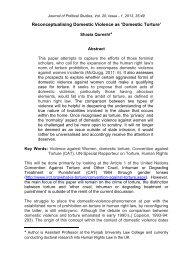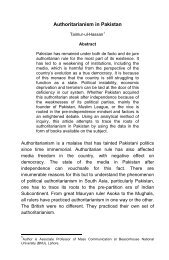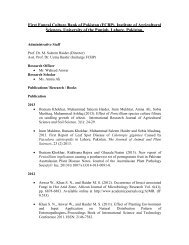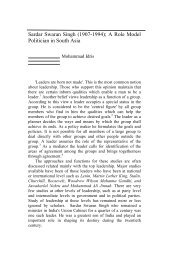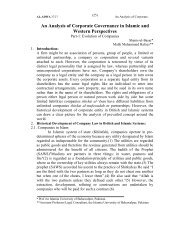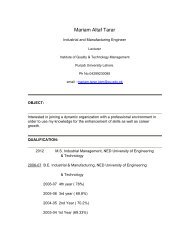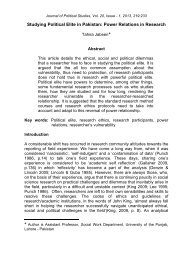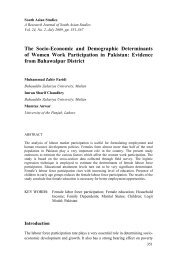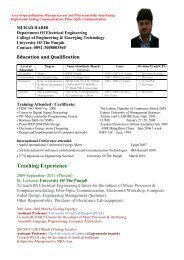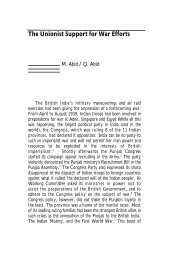Can Pakistan be a Secular State? - University of the Punjab
Can Pakistan be a Secular State? - University of the Punjab
Can Pakistan be a Secular State? - University of the Punjab
You also want an ePaper? Increase the reach of your titles
YUMPU automatically turns print PDFs into web optimized ePapers that Google loves.
South Asian Studies 28 (1)<br />
not only attendance and mem<strong>be</strong>rship <strong>of</strong> a church but <strong>the</strong>re is, however, ano<strong>the</strong>r<br />
way <strong>of</strong> looking at things. If we widen <strong>the</strong> definition <strong>of</strong> religion to include <strong>the</strong><br />
questions about <strong>the</strong> meaning <strong>of</strong> life, <strong>the</strong> purpose <strong>of</strong> mankind’s existence, <strong>the</strong> future<br />
<strong>of</strong> <strong>the</strong> planet and a human <strong>be</strong>ing’s responsibilities to his fellow human <strong>be</strong>ing and<br />
to <strong>the</strong> earth itself, we may find a very different pattern <strong>of</strong> religious <strong>be</strong>havior among<br />
<strong>the</strong> young. The evidence remains largely impressionistic but it seems likely that<br />
<strong>the</strong> 18-24 age-group may respond to <strong>the</strong>se pr<strong>of</strong>ound ecological, moral, ethical (and<br />
surely religious) issues much more positively than <strong>the</strong>y do to traditional religious<br />
instruction. Bearing this in mind, we might suggest <strong>the</strong> following ra<strong>the</strong>r tentative<br />
conclusion: religion and religious values are not so much disappearing among<br />
young people as <strong>be</strong>ing redirected. This redirection is, none<strong>the</strong>less, altering (very<br />
pr<strong>of</strong>oundly) <strong>the</strong> relationship <strong>be</strong>tween popular <strong>be</strong>lief and <strong>the</strong> institutional churches<br />
that is - surely - <strong>the</strong> relationship <strong>be</strong>tween <strong>be</strong>lieving and <strong>be</strong>longing. And it<br />
characterizes what might <strong>be</strong> termed <strong>the</strong> ‘implicit religion’ <strong>of</strong> British people in <strong>the</strong><br />
last decades <strong>of</strong> <strong>the</strong> 20th century” (Davie G. 1990).<br />
Talal Asad’s enquiry looks to <strong>be</strong> revealing raising <strong>the</strong> question as to whe<strong>the</strong>r<br />
anthropology as such contributes anything to <strong>the</strong> clarification <strong>of</strong> questions about<br />
secularism. He explains that, “most anthropologists are taught that <strong>the</strong>ir discipline<br />
is essentially defined by research technique (participant observation) carried out in<br />
a circumscri<strong>be</strong>d field, and that as such it deals with particularly – with what<br />
Clifford Geertz, following <strong>the</strong> philosopher Gil<strong>be</strong>rt Ryle, called ‘thick description”<br />
(Asad T. 2003:16). Clifford Geertz states that, “in anthropology, what <strong>the</strong><br />
practioners do is ethnography. The actual nature <strong>of</strong> ethnography is to do ‘thick<br />
descriptions’ that can <strong>be</strong> said to provide context and meaning to observed actions,<br />
ra<strong>the</strong>r than simply recording <strong>the</strong> occurrence <strong>of</strong> an event in isolation. It is more<br />
about recording <strong>the</strong> story <strong>of</strong> a fact, ra<strong>the</strong>r than <strong>the</strong> fact itself. It is <strong>the</strong> kind <strong>of</strong><br />
intellectual effort, an elaborate venture in ‘thick description’ <strong>of</strong> culture. Culture is<br />
a self-contained ‘super-organic’ reality with forces and purposes <strong>of</strong> its own; that is,<br />
to reify it” (Geertz C. 1973: 5-11). Referring to Ward Goodenough, Geertz writes<br />
that Culture (is located) in <strong>the</strong> minds and hearts <strong>of</strong> men (Ibid). Akin to that<br />
Norman Denzin perceives ‘thick description’ consisting <strong>of</strong> four features: first <strong>the</strong><br />
‘thick description’ gives <strong>the</strong> context <strong>of</strong> an act; second, states <strong>the</strong> intentions and<br />
meanings that organizes <strong>the</strong> action; third, traces <strong>the</strong> evolution and development <strong>of</strong><br />
<strong>the</strong> act and fourth, presents <strong>the</strong> action as a text that can <strong>the</strong>n <strong>be</strong> interpreted. A ‘thin<br />
description’ however, simply reports facts, independent <strong>of</strong> intentions or <strong>the</strong><br />
circumstances that surround an action (1989). In his article, “Religion as a Cultural<br />
System”, Clifford Geertz defines religion, “as (1) a system <strong>of</strong> symbols which acts<br />
to (2) establish powerful, pervasive and long lasting moods and motivations in<br />
men by (3) formulating conceptions <strong>of</strong> general order <strong>of</strong> existence and (4) clothing<br />
<strong>the</strong>se conceptions with such an aura <strong>of</strong> factuality that (5) <strong>the</strong> moods and<br />
motivations seem uniquely realistic” (Geertz C. 1973: 90).<br />
It is not arguable that human to human relationship is no more normative but<br />
is based on commercial terms due to “<strong>the</strong> depersonalization <strong>of</strong> urban life as an<br />
176


